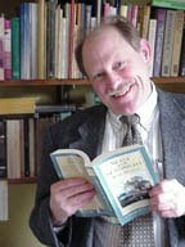
In Edmund A. LeFevre Professor of English John O'Neill's seminar on Jane Austen, students are reading the author's six books and watching film versions of the texts. That's nothing new.
What makes the course innovative is the way O'Neill is using different movie and television adaptations of the same novel to draw comparisons about how identical text can be interpreted differently. Using iMovie software, O'Neill's students compare two, sometimes three, films of the same book frame-by-frame, stopping to discuss the variations.
For example, the class viewed the 1971 British Broadcasting Corp. miniseries of Sense and Sensibility and the 1995 American film. In addition to production differences that made the U.S. version seem more vibrant than the BBC's, the directors' cinematic choices made the story take on different meanings.
"Normally it is portrayed that 'sense' is more desirable than 'sensibility' or that the two should be balanced. But in the American film, the romantic parts are so gorgeously romantic that you really get sucked in," O'Neill said. "Before 1990, I would never have used film in a class like this because a film can never be a substitute for a book. But by comparing scenes from two or more films, students begin to see the text in different ways, opening up new perspectives."
O'Neill developed the seminar with help from a Mellon Foundation grant and the expertise of the Hamilton Information & Learning Liaisons (HILLgroup), a collaboration between the library and Instructional Technology Services. He was the first to utilize Hamilton's new digital video workstation to design a course. The facility, located on the third floor of Burke Library, allows faculty members to experiment with ways to incorporate video/audio into their courses. (See an audio/visual example of O'Neill's course.)
The goal of the HILLgroup is to assist faculty members and students in the selection and use of technology and information resources that support teaching and research. Services range from assisting with database searches, to providing instruction in specialized software and hardware, to offering research and development support to faculty members designing new courses, including the new sophomore seminars to begin next year.
"The interdisciplinary nature of the sophomore seminar courses creates opportunities for novel and imaginative student presentations," said Janet Simons, instructional technology specialist. "Although we currently support student presentations, we are considering the broader scope and exploring the most effective ways to support student presentations long-term."
The HILLgroup and Susan Mason, director of the Program in Public Discourse, have been working on designing a flexible instruction curriculum (basic service model) that offers students an overview of the types of presentations (formal, debate, discussion, conflict management, peer tutoring, etc.) and the most effective technological tools options for each. Students will also receive discipline-specific research information skills, fair use or copyright literacy instructions and the opportunity to interact with support services representatives to ask questions and get an overview of the resources available.
"How this instruction curriculum would fit into the seminar course itself would depend on the unique needs of each course and the faculty members' ideas," Simons added. "As more faculty learn about the technology options that are available, our hope is to solicit feedback on ways we can address their needs."
For more information on the HILLgroup, visit the Web site above or e-mail HILLgroup@hamilton.edu.
Posted March 1, 2002
